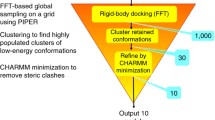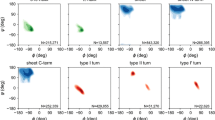Abstract
We recently reported on a new method called NMR Molecular Replacement that efficiently derives the structure of a protein—ligand complex at the interaction site. The method was successfully applied to high and low affinity complexes covering ligands from peptides to small molecules. The algorithm used in the NMR Molecular Replacement program has until now not been described in detail. Here, we present a complete description of the NMR Molecular Replacement implementation as well as several new features that further reduce the time required for structure elucidation.


modified by the user

taken from the PDB with the protein structure coloured in grey and every non-standard molecule, such as water ions and other organic molecules, coloured in red (PDB 5c5a). b The same protein structure as in (a) ready for the NMR2 structure calculation. The protein chain A was selected and protons were built. The non-standard molecules were removed, the small-molecule of interest was added, coloured in gold, and linked to the protein by “dummy atoms” coloured in blue

Similar content being viewed by others
Availability of data and material
Not applicable.
Code availability
Requests should be sent to the corresponding author.
References
Balaram P, Bothnerb AA, Breslow E (1972) Localization of tyrosine at binding-site of neurophysin Ii by negative nuclear overhauser effects. J Am Chem Soc 94:40174020
Breeze AL (2000) Isotope-filtered NMR methods for the study of biomolecular structure and interactions. Prog Nucl Magn Reson Spectrosc 36:323–372
Cavanagh J, Fairbrother WJ, Palmer AG, Rance M, Skleton NJ (2007) Protein NMR spectroscopy, principles and practice. Academic Press, San Diego, CA
Chen WN et al (2016) Sensitive NMR approach for determining the binding mode of tightly binding ligand molecules to protein targets. J Am Chem Soc 138:4539–4546
Cioffi M, Hunter CA, Packer MJ, Spitaleri A (2008) Determination of protein-ligand binding modes using complexation-induced changes in H-1 NMR chemical shift. J Med Chem 51:2512–2517
Clore GM, Schwieters CD (2003) Docking of protein-protein complexes on the basis of highly ambiguous intermolecular distance restraints derived from H-1(N)/N-15 chemical shift mapping and backbone N-15-H-1 residual dipolar couplings using conjoined rigid body/torsion angle dynamics. J Am Chem Soc 125:2902–2912
Constantine KL, Davis ME, Metzler WJ, Mueller L, Claus BL (2006) Protein-ligand NOE matching: a high-throughput method for binding pose evaluation that does not require protein NMR resonance assignments. J Am Chem Soc 128:7252–7263
Dominguez C, Boelens R, Bonvin AMJJ (2003) HADDOCK: a protein-protein docking approach based on biochemical or biophysical information. J Am Chem Soc 125:1731–1737
Gans P et al (2010) Stereospecific isotopic labeling of methyl groups for NMR spectroscopic studies of high-molecular-weight proteins. Angew Chem-Int Edn 49:1958–1962
Grishaev A, Llinas M (2002) CLOUDS, a protocol for deriving a molecular proton density via NMR. Proc Natl Acad Sci USA 99:6707–6712
Guan JY et al (2013) Small-molecule binding sites on proteins established by paramagnetic NMR spectroscopy. J Am Chem Soc 135:5859–5868
Guntert P, Buchner L (2015) Combined automated NOE assignment and structure calculation with CYANA. J Biomol NMR 62:453–471
Guntert P, Mumenthaler C, Wuthrich K (1997) Torsion angle dynamics for NMR structure calculation with the new program DYANA. J Mol Biol 273:283–298
Hajduk PJ et al (2004) SOS-NMR: a saturation transfer NMR-based method for determining the structures of protein-ligand complexes. J Am Chem Soc 126:2390–2398
Hillisch A, Pineda LF, Hilgenfeld R (2004) Utility of homology models in the drug discovery process. Drug Discovery Today 9:659–669
Jayalakshmi V, Krishna NR (2004) CORCEMA refinement of the bound ligand conformation within the protein binding pocket in reversibly forming weak complexes using STD-NMR intensities. J Magn Reson 168:36–45
Kaiser R (1965) Intermolecular nuclear overhauser effect in liquid solutions. J Chem Phys 42:1838–2000
Kay LE, Xu GY, Singer AU, Muhandiram DR, Formankay JD (1993) A gradient-enhanced hcch tocsy experiment for recording side-chain H-1 and C-13 correlations in H2o samples of proteins. J Magn Reson, Ser B 101:333–337
Kelman Z (2015) Isotope labeling of biomolecules—labeling methods. Methods Enzymol 565:XIX–XX
Kerfah R et al (2015a) Scrambling free combinatorial labeling of alanine-beta, isoleucine-delta 1, leucine-proS and valine-proS methyl groups for the detection of long range NOEs. J Biomol NMR 61:73–82
Kerfah R, Plevin MJ, Sounier R, Gans P, Boisbouvier J (2015b) Methyl-specific isotopic labeling: a molecular tool box for solution NMR studies of large proteins. Curr Opin Struct Biol 32:113
Kogler H, Sorensen OW, Bodenhausen G, Ernst RR (1983) Low-pass J-filters—suppression of neighbor peaks in heteronuclear relayed correlation spectra. J Magn Reson 55:157–163
McCoy MA, Wyss DF (2002) Spatial localization of ligand binding sites from electron current density surfaces calculated from NMR chemical shift perturbations. J Am Chem Soc 124:11758–11763
Neri D, Szyperski T, Otting G, Senn H, Wuthrich K (1989) Stereospecific nuclear magnetic-resonance assignments of the methyl-groups of valine and leucine in the DNA-binding domain of the 434-repressor by biosynthetically directed fractional C-13 labeling. Biochemistry 28:7510–7516
Ni F (1994) Recent developments in transferred noe methods. Prog Nucl Magn Reson Spectrosc 26:517–606
Nilges M (1995) Calculation of protein structures with ambiguous distance restraints—automated assignment of ambiguous noe crosspeaks and disulfide connectivities. J Mol Biol 245:645–660
Nilges M, O'Donoghue SI (1998) Ambiguous NOEs and automated NOE assignment. Prog Nucl Magn Reson Spectrosc 32:107–139
Nitsche C, Otting G (2018) NMR studies of ligand binding. Curr Opin Struct Biol 48:16–22
Noggle JH, Schirmer RE (1971) The nuclear overhauser effect. Academic Press, New York
Orts J et al (2008) Specific methyl group protonation for the measurement of pharmacophore-specific interligand NOE interactions. Chem-a Eur J 14:7517–7520
Orts J et al (2016) NMR-based determination of the 3D structure of the ligand-protein interaction site without protein resonance assignment. J Am Chem Soc 138:4393–4400
Orts J, Bartoschek S, Griesinger C, Monecke P, Carlomagno T (2012a) An NMR-based scoring function improves the accuracy of binding pose predictions by docking by two orders of magnitude. J Biomol NMR 52:23–30
Orts J, Gossert AD (2018) Structure determination of protein-ligand complexes by NMR in solution. Methods. https://doi.org/10.1016/j.ymeth.2018.01.019
Orts J, Vogeli B, Riek R (2012b) Relaxation matrix analysis of spin diffusion for the NMR structure calculation with eNOEs. J Chem Theory Comput 8:3483–3492
Pellecchia M et al (2002) NMR-based structural characterization of large protein-ligand interactions. J Biomol NMR 22:165–173
Pilla KB, Otting G, Huber T (2017) Protein structure determination by assembling super-secondary structure motifs using pseudocontact shifts. Structure 25:559–568
Proudfoot A, Frank AO, Ruggiu F, Mamo M, Lingel A (2016) Facilitating unambiguous NMR assignments and enabling higher probe density through selective labeling of all methyl containing amino acids. J Biomol NMR 65:15–27
Rossmann MG, Blow DM (1962) Detection of sub-units within crystallographic asymmetric unit. Acta Crystallogr A 15:24–000
Schieborr U et al (2005) How much NMR data is required to determine a protein-ligand complex structure? ChemBioChem 6:1891–1898
Siemons L, Mackenzie HW, Shukla VK, Hansen DF (2019) Intra-residue methyl-methyl correlations for valine and leucine residues in large proteins from a 3D-HMBC-HMQC experiment. J Biomol NMR 73:749–757
Torres F et al (2020) Protein–fragment complex structures derived by NMR molecular replacement. Chem RSC Med. https://doi.org/10.1039/D0MD00068J
Torres F, Orts J (2018) Nuclear magnetic resonance structure-based drug design. Future Med Chem 10:2373–2376
Tugarinov V, Kanelis V, Kay LE (2006) Isotope labeling strategies for the study of high-molecular-weight proteins by solution NMR spectroscopy. Nat Protoc 1:749–754
Vuister GW, Bax A (1992) Resolution enhancement and spectral editing of uniformly C-13-enriched proteins by homonuclear broad-band C-13 decoupling. J Magn Reson 98:428–435
Walti MA, Riek R, Orts J (2017) Fast NMR-based determination of the 3D structure of the binding site of protein-ligand complexes with weak affinity binders. Angew Chem-Int Edn 56:5208–5211
Wang B, Westerhoff LM, Merz KM (2007) A critical assessment of the performance of protein-ligand scoring functions based on NMR chemical shift perturbations. J Med Chem 50:5128–5134
Wälti M, Orts J (2018) The NMR2 method to determine rapidly the structure of the binding pocket of a protein-ligand complex with high accuracy. Magnetochemistry 4:12
Yilmaz EM, Guntert P (2015) NMR structure calculation for all small molecule ligands and non-standard residues from the PDB Chemical Component Dictionary. J Biomol NMR 63:21–37
Zwahlen C et al (1997) Methods for measurement of intermolecular NOEs by multinuclear NMR spectroscopy: application to a bacteriophage lambda N-peptide/boxB RNA complex. J Am Chem Soc 119:6711–6721
Acknowledgements
We thank the ETH Zürich, who supported this work. Figure 1 includes elements from the free medical images library https://smart.servier.com/ owned by Servier Medical Art and distributed under a creative common license. We thank Overall S. and Greenwald J. for careful reading of the manuscript.
Funding
The ETH Zürich supported this work.
Author information
Authors and Affiliations
Corresponding author
Ethics declarations
Conflict of interest
Not applicable.
Additional information
Publisher's Note
Springer Nature remains neutral with regard to jurisdictional claims in published maps and institutional affiliations.
Electronic supplementary material
Below is the link to the electronic supplementary material.
Rights and permissions
About this article
Cite this article
Orts, J., Riek, R. Protein—ligand structure determination with the NMR molecular replacement tool, NMR2. J Biomol NMR 74, 633–642 (2020). https://doi.org/10.1007/s10858-020-00324-y
Received:
Accepted:
Published:
Issue Date:
DOI: https://doi.org/10.1007/s10858-020-00324-y




